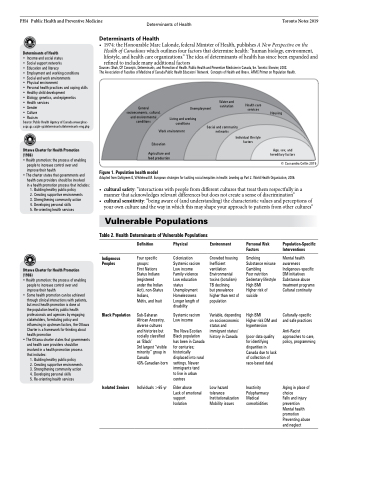Page 1222 - TNFlipTest
P. 1222
PH4 Public Health and Preventive Medicine Determinants of Health Toronto Notes 2019
Determinants of Health
• Income and social status
• Social support networks
• Educationandliteracy
• Employmentandworkingconditions • Social and work environments
• Physical environment
• Personal health practices and coping skills • Healthy child development
• Biology, genetics, and epigenetics
• Health services
• Gender
• Culture
• Racism
Source: Public Health Agency of Canada www.phac- aspc.gc.ca/ph-sp/determinants/determinants-eng.php
Ottawa Charter for Health Promotion (1986)
• Health promotion: the process of enabling
people to increase control over and
improve their health
• The charter states that governments and
health care providers should be involved
in a health promotion process that includes:
1. Building healthy public policy
2. Creating supportive environments 3. Strengthening community action 4. Developing personal skills
5. Re-orienting health services
Ottawa Charter for Health Promotion (1986)
• Health promotion: the process of enabling
people to increase control over and
improve their health
• Some health promotion can be achieved
through clinical interactions with patients, but most health promotion is done at
the population level by public health professionals and agencies by engaging stakeholders, formilating policy and influencing in upstream factors, the Ottawa Charter is a framework for thinking about health promotion
• The Ottawa charter states that governments and health care providers should be involved in a health promotion process
that includes:
1. Building healthy public policy
2. Creating supportive environments 3. Strengthening community action 4. Developing personal skills
5. Re-orienting health services
Determinants of Health
• 1974:theHonourableMarcLalonde,federalMinisterofHealth,publishesANewPerspectiveonthe Health of Canadians which outlines four factors that determine health: “human biology, environment, lifestyle, and health care organizations.” The idea of determinants of health has since been expanded and
refined to include many additional factors
Sources:Shah,CP.Concepts,Determinants,andPromotionofHealth.PublicHealthandPreventiveMedicineinCanada,5e.Toronto:Elsevier,2003. TheAssociationofFacultiesofMedicineofCanadaPublicHealthEducators’Network. ConceptsofHealthandIllness.AFMCPrimeronPopulationHealth.
General socioeconomic, cultural, and environmental conditions
Education
Agriculture and food production
Figure 1. Population health model
Water and sanitation
Health care services
Unemployment Living and working
Housing
Age, sex, and hereditary factors
© Cassandra Cetlin 2015
conditions Work environment
Social and community networks
Adapted from Dahlgreen G, Whitehead M. European strategies for tackling social inequities in health: Leveling up Part 2. World Health Organization, 2006.
• culturalsafety:“interactionswithpeoplefromdifferentculturesthattreatthemrespectfullyina manner that acknowledges relevant differences but does not create a sense of discrimination”
• culturalsensitivity:“beingawareof(andunderstanding)thecharacteristicvaluesandperceptionsof your own culture and the way in which this may shape your approach to patients from other cultures”
Individual lifestyle factors
Vulnerable Populations
Table 2. Health Determinants of Vulnerable Populations
Indigenous Peoples
Black Population
Isolated Seniors
Definition
Four specific groups:
First Nations Status Indians (registered under the Indian Act), non-Status Indians,
Métis, and Inuit
Sub-Saharan African Ancestry, diverse cultures and histories but socially classified as ‘Black’
3rd largest “visible minority” group in Canada
43% Canadian-born
Individuals >65 yr
Physical
Colonization Systemic racism Low income Family violence Low education status Unemployment Homelessness Longer length of disability
Systemic racism Low income
The Nova Scotian Black population has been in Canada for centuries; historically displaced into rural settings. Newer immigrants tend
to live in urban centres
Elder abuse
Lack of emotional support
Isolation
Environment
Crowded housing Inefficient ventilation Environmental toxins (botulism) TB declining
but prevalence higher than rest of population
Variable, depending on socioeconomic status and immigrant status/ history in Canada
Low hazard tolerance Institutionalization Mobility issues
Personal Risk Factors
Smoking Substance misuse Gambling
Poor nutrition Sedentary lifestyle High BMI
Higher risk of suicide
High BMI
Higher risk DM and hypertension
(poor data quality for identifying disparities in Canada due to lack of collection of race-based data)
Inactivity Polypharmacy Medical comorbidities
Population-Specific Interventions
Mental health awareness Indigenous-specific DM initiatives Substance abuse treatment programs Cultural continuity
Culturally-specific and safe practices
Anti-Racist approaches to care, policy, programming
Aging in place of choice
Falls and injury prevention Mental health promotion Preventing abuse and neglect


